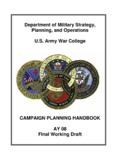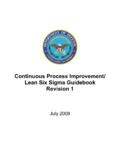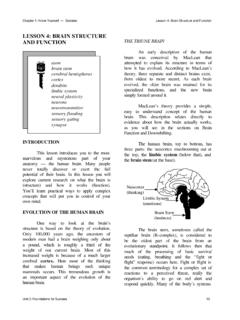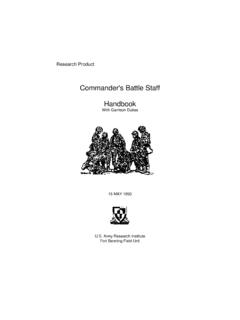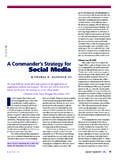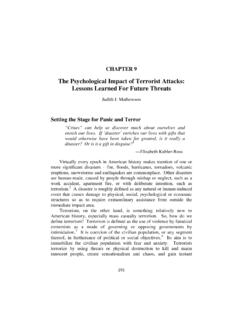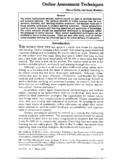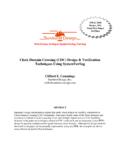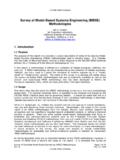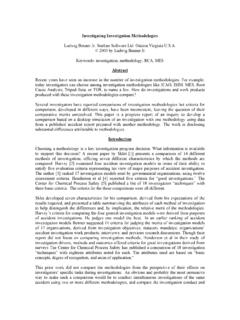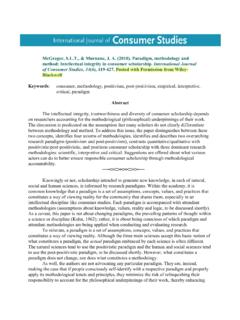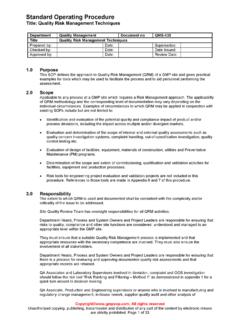Transcription of Root Cause Analysis - Air University
1 1 root Cause Analysis2 root Cause Analysis is a method that is used to address a problem or non-conformance, in order to get to the root Cause of the problem. It is used so we can correct or eliminate the Cause , and prevent the problem from recurring. Traditional applications of root Cause Analysis Resolution of customer complaints and returns. Disposition of non-conforming material (Scrap and Repair) via the Material Review process. Corrective action plans resulting from internal and customer Cause Analysis3 Through this training course, you will: Understand the meaning of root Cause Know the steps used to identify the root Cause of is root Cause ? root Cause is the fundamental breakdown or failure of a process which, when resolved, prevents a recurrence of the problem.
2 Or, in other words For a particular product problem, root Cause is the factor that, when you fix it, the problem goes away and doesn t come back. root Cause Analysis is a systematic approach to get to the true root causes of our process problems. 5 Philosophy of root Cause Analysis Each problem is an opportunity ( golden nugget ) because it can tell a story about why and how it occurred. It is critical that everyone take a personal and active role in improving quality. The true problem must be understood beforeaction is taken. Problems are often masked for a variety of reasons To do this well, we must be Both focused and open-minded Both patient and quick Above all, we must be relentless6We Perform root Cause Analysis to Prevent Turnbacks and Customer Escapes from RecurringDefectsOwnNextLaterBeforeFoundf ound at:ProcessProcessProcessReachingByStepSt epStepCustomerCustomerCost:Impact:VeryMi norReworkSignificantWarranty CostMinorDelayReworkRe-Admin.
3 Costschedule Delay inof Work DeliveryReputationAdditionalLoss ofInspectionMarket Share$1$10$100$1,000$10,0007 Symptom Approach vs. root CauseRoot Cause Errors are the result of defects in the system. People are only part of the process. We need to find out why this is happening, and implement mistake-proofs so it won t happen again. This is critical. We need to fix it for good, or it will come back and burn us. If we do a poor job of identifying the root causes of our problems, we will waste time and resources putting bandaids on the symptomsof the Approach Errors are often a result of worker carelessness. We need to train and motivate workers to be more careful. We don t have the time or resources to really get to the bottom of this problem. 8 How do we do root Cause Analysis ?
4 Said simply, root Cause Analysisis asking whythe problemoccurred, and then continuingto ask why thathappened until we reach the fundamental process element that failed. The following example illustrates the basics of root Cause Diagram -A Useful Tool Using a fishbone diagram while brainstorming possible causeshelps you to focus on the various possibilities. Some useful categories:PeoplePMProblemEnvironmentIns tructionsMeasuring/Test : The Washing MachineProblem Description Machine is 2 weeks old (Serial #2345017). When doing the fourth load of clothes, I heard a loud noise and the machine stopped! It wouldn t re-start. Problem Description Machine is 2 weeks old (Serial #2345017). When doing the fourth load of clothes, I heard a loud noise and the machine stopped!
5 It wouldn t re-start. 11 Verify the ComplaintProblem VerificationService technician checks washing machine operation to test procedure (#8496). The machine does not VerificationService technician checks washing machine operation to test procedure (#8496). The machine does not WhyMachine Doesn t WorkMachine Doesn t WorkFuseMissing?Machine Unplugged?PowerOff?FuseBlown?Fuse BlownWHY?WHY?Determinethe WhyMotor OverheatedWHY?WHY?Determinethe Action forSpecific Deficiency:Replace the FuseCorrective Action forSpecific Deficiency:Replace the Fuse14 Investigate WhyShaft DamagedWHY?WHY?Determinethe WhyBearing DestroyedWHY?WHY?Determinethe WhyLoss of LubeCause of Failure:Seal OmittedCorrective Action forSpecific Deficiency:Replace the MotorCorrective Action forSpecific Deficiency:Replace the MotorWHY?
6 WHY?Was SealOmitted??Was SealOmitted??Bearing DestroyedBearing DestroyedBadBearings?BearingLoads?SealOm itted?WrongBearings? is it? root Cause of our Example?InadequateAppropriateRoot Cause -InadequateWork InstructionsRoot Cause -InadequateWork InstructionsSealOmittedSealOmittedMissed Operation?OperatorError?PartsShortageIna dequateWorkInstructions?Fell Out? is it? root Cause of our Example? root Cause -InadequateWork InstructionsRoot Cause -InadequateWork InstructionsSealOmittedSealOmittedMissed Operation?OperatorError?PartsShortageIna dequateWorkInstructions?Fell Out?Can the design be changed to eliminate the need for a seal?Can the design be changed to make it impossible to omit the seal?Can a fixture be made to make it impossible to omit the seal?InadequateAppropriate19 CONTROL CHARTSXFISHBONE DIAGRAMHISTOGRAMPARETO CHARTRUN CHARTSTARTSTOP?
7 YNFLOWCHARTUCLLCLTIMEVALUEXSCATTER DIAGRAMYUSLLSLBRAINSTORMINGTREE DIAGRAMT ools Used in root Cause Analysis12345678 FACTOR AFACTOR BFACTOR C-+-+-+DESIGN OF EXPERIMENTS20 WHAT IS IT?Brainstorming is a process in which a group quickly generates asmany ideas as it can on a particular problem and/or IS IT USEFUL?Brainstorming is useful because it can help a group of people utilize its collective brainpower to generate many ideas in a short period of stimulates creativity and promotes involvement and IS IT USED?To help clarify mutual expectations and devise ground rules related to a team s way of IS IT DONE? Identify a topic, problem or issue and make sure there is mutualunderstanding of the task and objective. Write the topic on a flip chart. Each person presents one idea going in sequence (Round Robin).
8 If a person doesn t have an idea, pass and move on to the next person. All ideas are recorded on a flipchart. There is no evaluation or discussion during the session. Focus is on quantity of ideas, not the quality. When all ideas are exhausted, take a break. When you come back,people may have more ideas to add to the list. Keep the idea generation separate from the evaluation or Analysis of GUIDELINES: Generate as many ideas as possible. Encourage free-wheeling. No criticism is allowed, either positive or negative. Equal opportunity to participate. Record all ideas. Let the ideas Analysis ideas should be evaluated, further analyzed and refined prior to taking further IS IT?The Fishbone Diagram (also known as the Cause & Effect Diagram) is a technique to graphically identify and organize many possible causesof a problem (effect).
9 WHY IS IT USEFUL?Fishbone Diagrams help identify the most likely root causes of aproblem. They can also help teach a team to reach a common understanding of the problem. This tool can help focus problem solving and reduce subjective decision IS IT USED?When the need exists to display and explore many possible causesof a specific problem or condition. This diagram allows the team tosystematically analyze Cause & effect relationships. It can also help with the identification of root DOES IT LOOK LIKE?PROBLEM:ACHIEVE HIGHERBOWLING SCORESPEOPLEMETHODSMEASUREMENTMACHINESMA TERIALSENVIRONMENTATTITUDEALCOHOL INTAKEHOW MANY ON TEAM?-PACEEVERYONE SHOW UP?CURVE OR STRAIGHT BALLLENGTH OF ARMSWINGUSE OF ALLEY ARROWSAMOUNT OF PRACTICE# OF STEPS ON APPROACHSCOREKEEPER-MANUAL OR AUTOAUTO PINSETTERBALL CLEANERBALL MATERIALBALL WEIGHTSHOES USEDLANE OILTEMPERATURETIME OF YEARHUMIDITYNOISE FROM OTHER BOWLERSRAG CLEANUSE RAG TO WIPEOFF BALLUSE WRIST BAND?
10 TYPE OF WRIST BANDAMOUNT OF BALL LIFTBOWLING PROCESS INPUTSF ishbone Diagram22 HOW IS IT DONE? Name the effect; determine the specific problem to be analyzed. Draw the diagram with a process arrow to the effect and draw a box around it. Decide what the major categories of the causes are ( , people, machines, measurement, materials, methods, environment, policies, etc.). Label categories important to your situation. Make it work for you. Brainstorm all possible causes and label each Cause under the appropriate category. Post the diagram where others can add causes to it ( , experts, affected people, process owners, ). Analyze causes and eliminate trivial and/or frivolous ideas. Rank causes and circle the most likely ones for further consideration and study. Investigate the circled causes .
